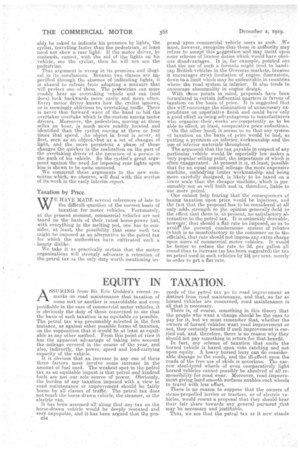Lights on Vehicles: The Commercial Vehicle View.
Page 1

Page 2

If you've noticed an error in this article please click here to report it so we can fix it.
USERS of commercial motor vehicles are concerned with four sections of the subject of the lighting of vehicles now in process of being considered by a committee formed by the Ministry of Transport. Those sections are (1) the screening of powerful headlights, (2) the positioning of lamps so as to indicate vehicle width, (3) the rear lighting of bicycles, and (4) the application of the new set of regulations complete to Scotland and Ireland so as to secure uniformity throughout the United Kingdom. Three of these points call for scarcely more than a mention here. Powerful headlights can easily be so screened that the upper half of the cone of rays can be cut off or deflected downwards. There is no need for the projected beam to be higher than 5 ft. With this much-needed change the difficulty of lorry driving at night, when confronted with a pair of car headlights, will be materially diminished. As to vehicle width, we think that it will be found that the side lamps will be required to be fixed on the centreline of the mudguards, and then the distance between lamps will be (as should be the case) a fair indication of the width of the vehicle one is passing. With regard to the rear lighting of bicycles, we trust that the objection of a noisy section of cyclists to what seems an obvious and logical course will be sternly overruled. Cyclists themselves are a divided camp on this question, for, long before Dora's enactment made rear lights on cycles compulsory, many thousands of cyclists had fitted rear lamps, and red reflecting mirrors in order to indicate their presence on the road at night to following vehicles. When a bicycle rider becomes cenverted to motorcycling he accepts the rear light without a murmur. When he fits one of the Auto-Wheels or like devices he does the same. Yet, as a cyclist, he wishes to contend that, of three types of machines closely similar, one of them need not show a rear light. He arrives at this curious conclusion from the illogical argument that, because the pedestrian cannot reason ably be asked to indicate his presence by lights, the cyclist, travelling faster than the pedestrian, at least need not show a rear light. If the motor driver, he contends, cannot, with the aid of the lights on his vehicle, see the cyclist, then he will not see the pedestrian. That. argument is wrong in its premises and illogical in its conclusions. Because two classes are imperilled through the absence of indicating lights, it is absurd to refrain from adopting a measure that will protect one of them. The pedestrian can more readily hear an overtaking vehicle and can (and does) look backwards more easily and more often. Every motor driver knows how the cyclist ignores, or is seemingly oblivious to, overtaking traffic. There is never that forward wave of the hand to bid the overtaker overtake which is thee custom among motor drivers. Moreover, the pedestrian, moving at three miles an hour, is much more readily located and identified than the cyclist moving at three or four times that speed. An object in front is never, at first, seen as an object,tbut as a set of changes of light, and the more persistent a phase of those changes the quicker is:the realization on the part of the overtaking driver of the presence of a person in the path of his vehicle. So the' cyclists great argument against the need for imposing rear lights upon him is shown to be quite unsound. • We commend these arguments to the new committee which, we observe, will deal with this section of. its work in the early interim report. "


























